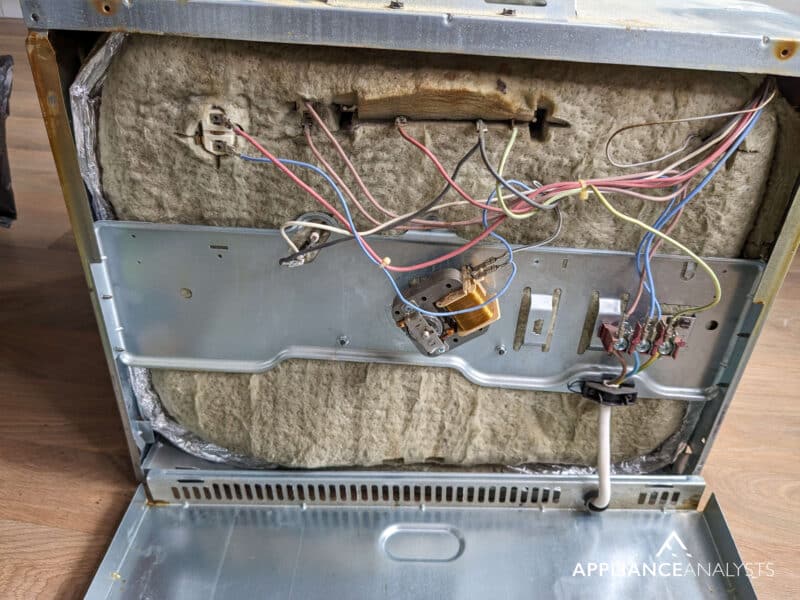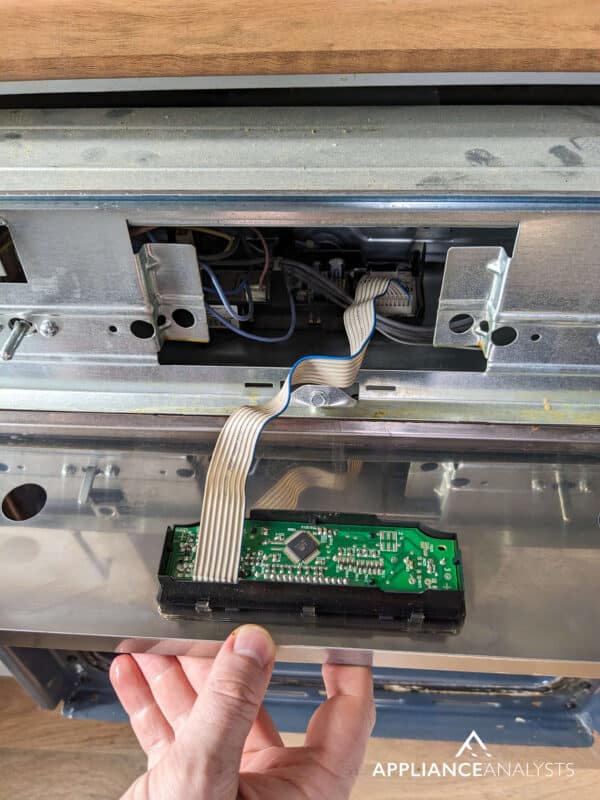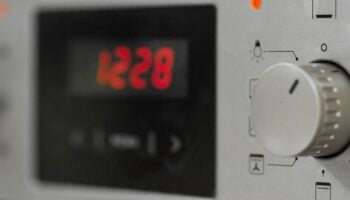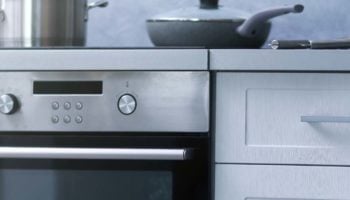We've independently reviewed this article to make sure it's as accurate as we can make it.
To find out more about our article creation and review process, check out our editorial guidelines.
Stuck trying to figure out why your oven’s light is always on?
You’re not alone! Being unable to turn off your oven’s light can be quite frustrating, especially when you’re trying to save energy.
Luckily, you’ve come to the right place to fix the problem.
If your oven’s light is always on, you’ll need to perform a reset, check the settings, and test the door switch. If the issue persists, please replace the light bulb, inspect the wiring, and examine the control board.
Keep reading to fix your oven’s light!
Why trust us? This article was written by Craig Anderson and James Blackford.
Craig has helped thousands of other homeowners repair their appliances since 2016.
James is one of our resident appliance experts with over 16 years of experience. He currently works as a Master Technician for SquareTrade, and runs his own appliance repair business.
Oven Light Refusing to Turn Off? Try These 7 Fixes
An oven light can refuse to turn off due to different reasons. But don’t worry – in this section, I’ve prepared a list of seven helpful tips that will help you solve the issue today.
Ready? Let’s get started!
#1 Reset Your Oven
If your oven’s light won’t turn off, I recommend starting with a reset.
Sometimes, ovens can encounter minor software errors that lead to malfunctions in some of their components. Luckily, performing a reset can effectively clear these glitches and fix the problem.
To reset your oven, you’ll need to:
- Carefully move your oven to reach the power cord.
- Unplug the oven from the power outlet and wait for a few minutes.
- Plug your oven back into its power source.
- Check the oven’s interior to see if the light is still turned on.
If you can’t reach the power cord, you can also reset the oven by turning its circuit breaker off and back on.

If the light is still on, you’ll need to check the settings. Read on to learn how to do it.
#2 Check the Settings
I’ve seen that some ovens offer a feature that allows you to keep the oven light on continuously.
In traditional ovens, the light option is typically controlled by a switch or dial. However, in digital ovens, you’ll usually find the light option in the “Settings” or “Options” menu. For detailed instructions on locating the light settings on your specific oven model, please consult the manufacturer’s manual.
Can’t find your manual? I’ve got you! Click on the link below to learn how to find any product’s manual online!
Once you’ve located the light settings on your oven, you can choose to either turn it off (if it’s controlled by a switch or dial) or set it to a mode where it only activates during cooking.
#3 Check the Door
In my experience, if the oven door is not closed properly, the light can stay on.
You see, some ovens have a switch that automatically turns on the light when the door opens. So, if the door isn’t fully shut, the light will refuse to turn off.

In such cases, my usual advice is to ensure the oven racks are properly installed. If they’re obstructing the door, please readjust them.
It’s also important to clean the door hinges with warm water and vinegar. If they’re dirty, they can prevent the door from closing. While you’re at it, please visually inspect the hinges. If they’re damaged, you’ll need to replace them.
Don’t forget to check the door seal (or gasket). If it’s damaged, you’ll also need to replace it with a new one to ensure the door closes properly.
#4 Test the Door Switch
If the door is properly closed, but the light still won’t turn off, you’ll need to inspect the door switch.
Certain ovens have a door switch or sensor that activates the light when the door is opened. If the switch malfunctions, it can incorrectly think that the door is open, even when it’s closed, and keep the light on. In such cases, you’ll need to test the door switch.
Please refer to the manufacturer’s manual for detailed instructions on accessing the door switch, as the process can vary depending on the specific model you own. Keep a screwdriver handy, as you’ll need to remove some panels.
Once you’ve accessed the door switch, use a multimeter to test it for continuity. If it doesn’t show continuity, it indicates that it is faulty, and you’ll need a replacement.
#5 Replace the Light Bulb
Now, it’s time to rule out the light bulb as our possible culprit.
You see, light bulbs, especially the lower-quality ones, can have internal defects that can lead to unexpected behavior.

Luckily, replacing your oven’s light bulb is very simple. You’ll just need to:
- Get a compatible light bulb. Ovens require specific bulbs that can handle high temperatures.
- Unplug your oven from the power outlet to prevent electrical hazards and let it cool down.
- Open the door and remove the light bulb protective cover by twisting or rotating it counterclockwise. Keep in mind that the process of removing the cover will vary depending on the specific model you own, so please refer to the owner’s manual.
- Unscrew the old bulb counterclockwise.
- Install the new, compatible bulb and reattach the protective cover.
Once you’ve replaced the light bulb, please plug your oven back into the power outlet and test the light. If it still refuses to turn off, you’ll need to inspect the wiring and control board. Read on to learn how to do it.
#6 Inspect the Wiring
I find that when an oven light doesn’t turn off, it’s typically due to an issue with the wiring that leads to the oven light.
If there’s a short in the wiring or a loose connection, your oven’s light can stay on even when it shouldn’t. Therefore, it’s important to inspect the wiring. Here’s how to do it:
- Unplug your oven from its power source or ensure the circuit breaker is turned off. Make sure the oven has cooled down if it was recently used.
- Remove the oven’s back panel to access the wiring connections for the oven light.
- Locate the wiring that leads to the oven light and look for any signs of damage, such as burnt areas or loose connections.
- Tighten any loose connections and replace the damaged wires.

Keep in mind that if you’re unsure or if the problem seems complex, it’s best to call an appliance repair expert. They’ll be able to diagnose and solve the problem.
#7 Examine the Control Board
If you’ve tried all of the fixes above, but your oven light is still refusing to turn off, then there’s a good chance the control board is malfunctioning.
The control board is responsible for managing different functions, including your oven’s light. So, if the control board is faulty, it can lead to the oven light being turned on continuously.

While you can test and replace the control board, I recommend consulting your warranty status and calling a professional because accessing the control board or relays can often be challenging and expensive.
So, if you’ve recently purchased your oven, it’s likely that you can get it repaired for free.
Wrapping Up: Steps to Fix Your Oven’s Light
Hopefully, now you know how to fix your oven’s light.
Remember that if your oven light won’t turn off, you’ll need to reset the unit, check the light settings, make sure the door is properly closed, and replace the light bulb. If the issue persists, don’t forget to inspect the door switch, wiring, and control board.
Thank you so much for taking the time to read this article. If you’ve found it helpful, please check out our other related posts below.
Have a great day!









